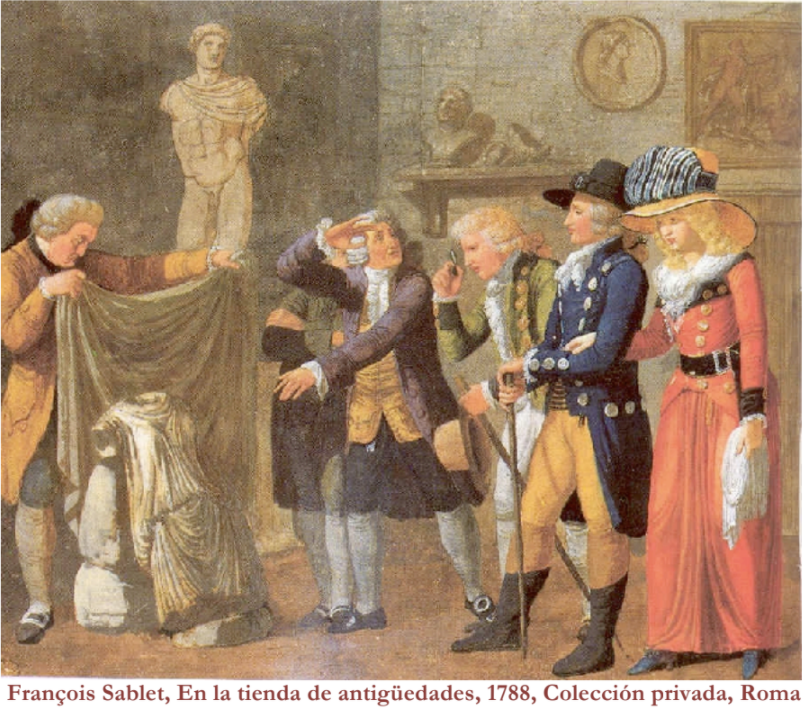International conference “Buying Art and Antiquities in Eighteenth Century Italy” (online, 4, 11, 18, 23th Nov.- 2nd Dec. 2021, UNED, Madrid)

To get online access (ZOOM): dojeda@geo.uned.es; diezdelcorral@geo.uned.es
Also available in streaming (without registration): https://canal.uned.es/live/event/615d5ddfb6092370f0279a25
This conference is part of the results of the I+D+i project (PID2020-117326GB-I00), FAKE- La perdurabilidad del engaño: Falsificación de Antigüedades en la Roma del siglo XVIII, and the Ramón y Cajal research Project (2017-22131), Academias artísticas, diplomacia e identidad de España y Portugal en la Roma de la primera mitad del siglo XVIII, both funded by the Ministerio de Ciencia e Innovación.
The 3rd meeting of the International Conference series “Transnational relations and the Arts” seeks to approach the issue of Art and Antiquities markets in 18th Century. The educational and transformative study travel, known as the Grand Tour, was at its peak and well-groomed men from all over Europe and beyond flooded in the cities of Italy, mainly Rome but also Naples, Venice or Florence. Those grand tourists fed an already flourishing art market and were also active agents of the spread of ancient marbles and vases, old masters paintings, etc. among their homelands, not to mention the diffusion of a some sort of international “buon gusto” among the medium and high classes.
First Session- Agents and art markets – 4th of November
15:00 h. Madrid Time Zone
Sascha Kansteiner, Curator of Greek and Roman sculpture, Staatliche Kunstsammlungen
Dresden, Cavaceppi – sculptor, restorer, dealer, publisher and forger.
Jeffrey Laird Collins, Professor of Art History and Material Culture (Bard Graduate Center, NY), The Pope, the Curator, the Milord, and his Dealer: Rome’s Red-Hot Antiquities Market in Theory and in Practice.
Heiner Krellig, independent scholar, Venice- Berlin, Preliminary notes for a history of the art market in 18th Century Venice.
16:15-16:30 h. Coffee break
Paola D’Alconzo, Universidad de Nápoles Federico II, Il mercato di antichità nel Regno di Napoli nel XVIII secolo: quadro normativo e alcuni casi esemplari.
Alexandre Vico Martori, Universidad de Gerona, “Quattro quadri dipinti per il traverso dipinti in tavola”: El redescubrimiento de Sandro Botticelli y la adquisición de las spalliere del Palazzo Pucci.
Second Session- Agents and art markets II – 11th of November
15:00 h. Madrid Time Zone
Paweł Gołyźniak, Institute of Archaeology, Jagiellonian University, Philipp von Stosch (1691-1757) and his dominant position in terms of trade, collecting and research of engraved gems in the eighteenth-century Italy.
Tara Zanardi, Hunter College of the City University of New York, Isabel de Farnesio, Filippo Juvarra, and the Modern Interior at La Granja.
Mercedes Simal, Unversidad de Jaén, Troiano Acquaviva y el mercado artístico romano: un agente al servicio de los reyes de España y Nápoles.
16:15-16:30 h. Coffee break
Elena Dmitrieva, Department of the Classical Antiquities, The State Hermitage Museum, Russian buyers of antique and modern gems in the Italian art market in the second half of the 18th century.
Odile Boubakeur, Ecole du Louvre / Université Paris-Saclay, “Italy, garden of the world”…or “jardin à l’anglaise” ? British supremacy on the Italian antic art market through the 18th century.
Third Session – Collectors and their collections – 18th of November
15:00 h. Madrid Time Zone
Tracy L. Ehrlich, Associate Teaching Professor (Parsons School of Design/The New School, NY), , Alessandro Albani and European Practices of Collecting and Display in the Era of the Grand Tour.
Fabrizio Federici, independent scholar, Dispersing a collection in 18th-century Italy: the paintings and statues of the Cybo Malaspina family.
John E. Davies, FRHistS, former County Archivist Carmarthenshire Archive Service, independent scholar, An examination of the art collecting of the first baron Cawdor.
16:15-16:30 h. Coffee break
Theresa Kutasz Christensen, Exhibitions Researcher,
Prints, Drawings, and Photographs, Baltimore Museum of Art, USA, The King is Dead, Long Live the King’s Things: The Transformation of Private Pleasures into Public Propaganda in Gustav III of Sweden’s Museum of Antiquities.
Alexander V. Kruglov, independent scholar, NY, The Russian Grand Tour: sculptures purchased by Count and Countess of the North in Rome in 1782.
Fourth Session – Collectors and collections – 23th of November
15:00 h. Madrid Time Zone
Daniela Roberts, Assistant professor at the Institute of Art History of the University of Würzburg, Grand Tour Pickings – Antiquities for Georgian Gothic Houses.
Maureen Cassidy-Geiger, independent scholar, USA, Bringing Rome Home: Souvenirs and gifts for Crown Prince Friedrich Christian of Saxony/Poland during his sojourn in the Eternal City, 1738-1739.
José Antonio Vigara Zafra, UNED, El Grand Tour del VI conde de Fernán Núñez: un ejemplo de cultura cortesana en la Europa de la Ilustración.
16:15-16:30 h. Coffee break
Domenico Pino, University College London, Gems never seen before: William Hamilton, Vesuvius and the rising taste for precious marble in Europe c. 1770.
Ginevra Odone, Université de Lorraine / La Sapienza Università di Roma / Society for the History of Collecting – Italian Chapter, From Rome to London. Expertise, dealer and buyer for «Two antique hands» .
Fifth Session – Works of art – 2nd of December
15:00 h. Madrid Time Zone
Max Kunze. Professor at the University of Mannheim, Winckelmann and the Venus Menophantus or emphatic aspects of restored sculptures in the 18th century.
Alexis R. Culotta, Professor of Practice, Tulane University (USA), Commemorating Italy?: The Walpole and Brand Cabinets as Grand Tour Souvenirs of Elsewhere.
David Ojeda, UNED, Forgeries in the 18th Century and Classical Art: a methodological conundrum.
16:00-16:15 h. Coffee break
Julio C. Ruiz, Universidad Rovira i Virgili, Tarragona, Sobre un torso masculino con indumentaria militar en el Museo del Prado.
Lorenzo Ebanista, independent scholar, La felloplastica napoletana nel XVIII secolo tra scenografie presepiali, souvenirs del Grand Tour e rappresentazioni naturalistiche.
Eliška Petřeková, Masaryk University Brno, Between a souvenir and archeological documentation: The cork model of the Paestum temple in the chancellor Metternich‘s collection.
Closing remarks:
David Ojeda & Pilar Diez del Corral Corredoira

